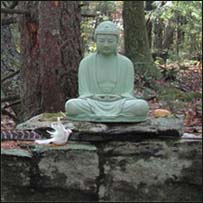|
|
 |
Please support Dharma Seed with a 2025 year-end gift.
Your donations allow us to offer these teachings online to all.

|

|

|
The greatest gift is the
gift of the teachings
|
|

|
| |
|
Dharma Talks
|
2017-02-10
Open to Impact - Awakening the Human Heart
42:29
|
|
Leela Sarti
|
|
|
"wisdom does not inspect, but behold. We must look a long time before we can see." - Henry David Thoreau. The willingness and capacity to feel vulnerable and respond to oneself with kindness is a sacred gateway to being a true human being and to live this earthly life with dignity and depth of being. The practice of meditation is to behold oneself.
|
|
Gaia House
:
Wholehearted Living
|
|
|
2017-02-04
Patience in Practice and Life (Retreat at Spirit Rock)
55:25
|
|
Sally Armstrong
|
|
|
Patience is one of the paramis, the 10 beautiful qualities of the heart/mind that we develop in our sincere practice. Patience is essential if we are to deepen in meditation, especially on long retreats, as it allows us to be present when things are difficult or not exciting, which can be a lot of the time! True patience not just tolerance, a willingness to put up with things until they get better. Patience is a full body experience, a commitment to being present with care and acceptance. Patience brings with it many other wholesome factors such as contentment and equanimity.
|
|
Spirit Rock Meditation Center
:
February Month-long Retreat
|
|
|
2017-01-29
Wise retreat (Retreat at Spirit Rock)
55:49
|
|
Sally Armstrong
|
|
|
For some people, the idea of retreat implies some form of escape or avoidance. But actually, meditation retreats, especially long ones, are deep dive into our direct experience, both individual and collective. Though we disengage from the busyness and distractions of our daily life, we are still deeply engaged in understanding the world and our place in it, and can return from retreat more balanced and compassionate, ready to engage wisely with our lives and the issues of our time.
|
|
Spirit Rock Meditation Center
:
February Month-long Retreat
|
|
|
|
|